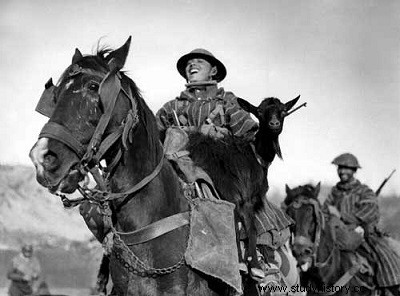
On the evening of the 12th and during the day of the 13th, the divisions of Oran and Algiers push towards the east strong detachments which will complete the liaison with the British and French forces of the Armed City.
At the Algiers division, General Conne launched, on the 12th, on the Zriba - Bou-Ficha axis, an exploitation detachment made up of the group of Moroccan tabors of Colonel de La Tour. The village of Zriba was taken in the evening, but an Italian regiment, whose fine resistance should be noted (125th Infantry Regiment, Colonel Chiaramonti), held firm, until 1 p.m. at 10 a.m., the Jebel Zriba which dominated the village. The exploitation detachment can then go and liaise with the English at Bou-Ficha.
At the Oran division, the armored group
Le Couteulx, coming from Sainte-Marie-du-Zit, reached Djeradou on the 13th at noon, where he established contact with General de Larminat's 1st Free French Division (Ire D.F.L.).
In both divisions, these movements are accompanied by sensational captures! At the division of Oran, on the night of the 12th to the 13th, high-quality parliamentarians were brought to General Boissau's headquarters at Sainte-Marie-du-Zit:General Mancinelli, Chief of Staff of General Messe, commander of the 1st Italian Army, ex-army Rommel, accompanied by Colonel Mackert, representing the German units of this army.
At the Algiers division, he is the head of state - major of the 21st Italian corps (Italian “Spezia” and “Pistoia” divisions and German 164th D.I.) who reports to the division's exploitation detachment.
An element of the exploitation detachment, the 59th Goum picks up on the road a column which presents itself, made up of nearly 200 Axis trucks loaded with men, Germans and Italians. On this single day of the 13th, they will direct some 6,000 prisoners to our rear.
As for the Algiers division, stopped on the spot in front of the south face of the Zaghouan, on the road to Saouaf, in this valley which one could not cross without triggering artillery barrages and which is now filled with a surprising silence, she contemplates this djebel Leri, southern buttress of Zaghouan, against which was still breaking, on May 10 in the aftermath - noon, the assault of the Bouvattier battalion (III/9 R.T.A.).
Now, this evening of May 12, that is to say two days later, we can examine, without fear this time, this great peak of Zaghouan from which it was necessary to hide as from an enemy because, from the top of its 1,295 meters, the observers of the enemy artillery placed their shells as if by hand in the valley and the ravines. “You are seen from Zaghouan! we repeated. The cannon having fallen silent and the arms being laid down, our skirmishers, resting on the spot, contemplate in the distance the long lines of Germans and Italians who descend from the massif by all the tracks, like the rats who leave the ship in perdition.
The next day, May 13, out of the 34,500 prisoners that General Kceltz's 19th corps will count, around fifteen thousand Germans and Italians are already gathered under the burning sun, in a large dry field, summarily enclosed with barbed wire. behind the small destroyed station of Pont-duFahs. These are the remains of this reputedly invincible Afrika Korps. And it was such a spectacle that Colonel Maunier-Condroyer had all our officers and skirmishers of the 9th R.T.A. so that, after suffering and struggling for months in the desolate jebels, in the winter wind and rain, they may see the tangible result of their efforts and sacrifices.
The May 13, at 1 p.m., a few hours after the rocks of Zaghouan echoed the echo of the last cannon shot fired in Africa, General Alexander was able to send Winston Churchill the following telegram:
Prime Minister, it is my duty to report to you that the Tunisia campaign is over. All enemy resistance ceased. We are masters of the North African shores.
